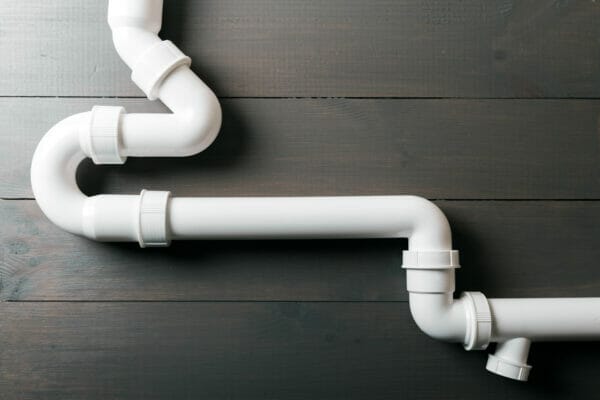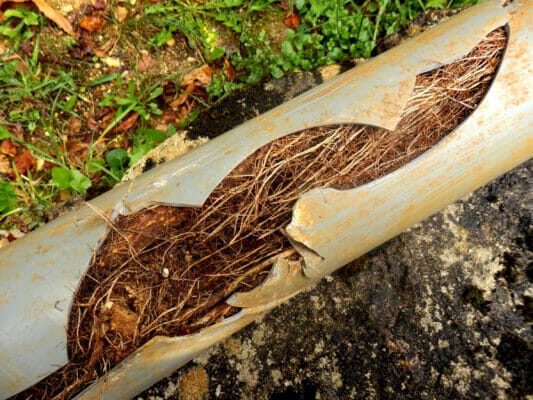Disclaimer: This post may contain affiliate links, meaning we get a small commission if you make a purchase through our links, at no cost to you. For more information, please visit our Disclaimer Page.
PVC pipe is a popular plumbing material, used in homes to provide water and other utilities. So do they become more fragile as they age?
PVC pipes become brittle with age because their chemical composition allows for degradation when exposed to different conditions. They are made of plasticizers that leach out of the PVC pipes as they continue to age, causing them to become hard and brittle.

Table of Contents
How Long Does A PVC Pipe Last For?
Polyvinyl Chloride (PVC) is a popular choice for most plumbing activities, thanks to its low cost, durability, and lightweight. Most of the PVC pipes available in the plumbing industry have a life expectancy of 30-50 years without cracking or breaking.
However, the PVC pipe’s lifespan is dependent on different factors that contribute to its weakening. These factors can accelerate the rate at which the PVC pipe weakens, making it brittle and easy to break. They include:
Cold temperatures
When the temperature drops, the PVC contracts and hardens. In this hardened state, it can easily break when some force is applied to it. Even a small impact would make it crack. It gets even worse when the cold temperatures persist for a long time.
This is prone in regions that experience winter periods for several months. The PVC pipes do not last too long because of the impact of the chilling weather during the cold winter season.
To protect the PVC pipes from the harsh weather, you can bury them underground or in concrete because the soil or the concrete is not too affected by the weather.
Exposure to harsh chemicals
The PVC pipes are made of polymers that can react with chemicals. These reactions can change their structure and loosen their bonds significantly.
With continued exposure to these chemicals, the PVC pipes become brittle and can easily break.
An example of these harsh chemicals is the clog remover that is used to clean and unblock clogged drainage systems. They contain highly reactive chemicals that disintegrate the clogs within seconds and flush them down.
They react vigorously, generating a lot of heat. This heat affects the composition of the plastic PVC pipes and causes them to wear off and weaken. It’s not recommended to use these chemicals so that the PVC pipes can last longer.
Age
As time goes by, the PVC pipe undergoes degradation, and its composition becomes altered. This is because the plasticizers used in making the PVC pipes leach out and can, in return, weaken the PVC.
It’s not an immediate process, it’s a process that takes years, and it is affected by other factors like environmental conditions.
If you have a brand new PVC pipe and a PVC pipe as old as 10 years, their strength will be different. You’ll notice that the older one is weaker compared to the new one.
Exposure to high temperatures
Effects of temperature apply in both ways. High temperatures increase the movement of the plasticizers within the pipe and boost the rate at which they are leaching.
Heat will accelerate the dissolving rate for these plasticizers and, in turn, weaken the pipe.
Like in cold temperatures, the best way to protect your PVC pipe and ensure they last long is by hiding them and installing them underground where there’s less temperature variation.
Exposure to sunlight
The sunlight has ultraviolet sun rays, which contribute largely to the polymer degradation of the PVC pipes, causing them to crack and break.
PVC pipes that are always exposed to sunlight fade their color and then lift and break.
The change in color is a result of the oxidizing properties of the UV light on the polymer composition. The polymer absorbs the UV light and the heat from the sun and undergoes an oxidation process that disorients the chemical composition of the PVC pipe.
The only remedy to this is to install PVC pipes underground where they are safe from direct sunlight.

Does PVC Pipe Get Brittle With Age?
As mentioned earlier, a PVC pipe weakens with age and becomes brittle as it continues to lose more plasticizers. The time differs for different PVC pipes depending on the polymers used in making them. Let’s look at how it works.
Polymers experience different stages of degradation over time while they are in storage or in service. As mentioned earlier, the degradation is accelerated by factors like temperature variation, exposure to sunlight, and exposure to chemicals.
These factors encourage the strengthening of chemical bonds and their crosslinks between the molecular chains of the polymer.
When the bond is stronger, the polymer’s macromolecular chains become tightly held together and therefore cannot move flexibly as they used to move before.
The polymer becomes hard and brittle, such that it can break easily on a small impact. That means the polymer’s behavior changes and cannot function effectively as before due to the impact of aging.
Does PVC Pipe Break Easily?
PVC pipes are designed with high flexibility so that they don’t break easily.
They also have additive materials added to the polymer, which help to stabilize the plastic and hinder fast degradation when exposed to different conditions.
However, no matter the number of additives added to the PVC, degradation takes place over time, leading the pipe to break.
Since degradation will happen anyway, the best thing you can do is to protect your PVC pipes from these factors that accelerate degradation so that they can serve you longer.
Here Are Some Ways You Can Protect Your PVC Pipe
Paint the PVC pipes to protect them from the sun
PVC pipes are not meant for indoors only. And so, you may need to use PVC pipes outdoors, and so you’ll have to protect it from the sun. To do this effectively, you can paint the PVC pipe using water-based latex paint or a PVC primer designed for this purpose.
Ensure that your paint is brightly colored so that the bright color can reflect back the sunlight and protect the pipe from overheating.
Before applying the paint, ensure that you clean the pipe properly to get rid of any dirt that may interfere with the paint’s adherence to the pipe.
Install the pipe underground
This is the surest way to protect your PVC pipe because it will not be exposed to any adverse weather conditions which contribute to degradation. You’ll notice that the pipe that is hidden underground lasts longer compared to one that is installed on the surface and exposed to the sun.
When installing the pipe underground, ensure that it is deep enough so that it is not affected by any kind of force exerted on the surface.
For example, if you are installing the PVC pipe in an area where cars pass through often, you must ensure that you put the pipe deep enough where the weight of the car will have no effect on it.
One downside about installing the pipe underground is that it is possible for the PVC pipe to become damaged as a result of the weathering underground rocks.
In places where it snows, water can seep into the ground and freeze there, causing unstable temperature conditions there. This can lead to pipe damage.
How Much Weight Can A PVC Pipe Support?
A PVC has high tensile strength and can withstand lateral compression. However, the exact weight it can support is dependent on its thickness and diameter.
For example, a 1.5-inch diameter PVC pipe with a Schedule 40 as per the standard can withstand a load of over 200 lbs.
Other factors like the operating temperature of the piping system and the material of the pipe all affect the weight it can carry. For example, if a PVC pipe is used to transmit hot water, it may hold less weight compared to one conducting cold water.
Also, some pipes have spring support that allows them to withstand loads of 1,750 lbs to 21,280 lbs. That means a car can pass over them, and they remain intact.
